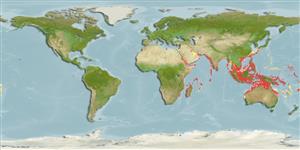>
Clupeiformes (Herrings) >
Dorosomatidae (Gizzard shads and sardinellas)
Etymology: Amblygaster: Greek, amblys = darkness + Greek, gaster = stomach (Ref. 45335).
More on author: Walbaum.
Environment: milieu / climate zone / depth range / distribution range
Ecologie
marien; brak water rifbewoner; diepte 10 - 75 m (Ref. 12260). Tropical; 35°N - 28°S, 31°E - 178°W (Ref. 188)
Indo-West Pacific: Red Sea and Mozambique to the Philippines, north to Taiwan and Okinawa (Japan), south to New Guinea, the Arafura Sea (Ref. 9819), northern Australia, and Fiji.
Lengte bij maturiteit / Grootte / Gewicht / Leeftijd
Maturity: Lm 15.0 range ? - ? cm
Max length : 27.0 cm SL mannelijk / geslacht onbekend; (Ref. 54980); common length : 20.0 cm SL mannelijk / geslacht onbekend; (Ref. 188); max. gerapporteerde leeftijd: 8 Jaren (Ref. 1488)
Dorsale stekels (totaal): 0; Dorsale zachte stralen (totaal): 13-21; Anale stekels 0; Anale zachte stralen: 12 - 23. Diagnosis: Body slender, belly rather rounded, scutes not prominent (Ref. 188). It is distinguished from Amblygaster clupeoides and A. leiogaster by the presence of a series of 10-20 gold, in life, or black, on preservation, spots down the flank, but sometimes missing; also, lower gillrakers 33-43, while 26-33 in the other two species (Ref. 188). Sardinops species are also round-bodied and have spots on the flanks, but possess bony radiating striae on the gill cover; round-bodied Sardinella species have one unbranched and 8 branched pelvic finrays while Amblygaster sirm has one unbranched and 7 branched pelvic finrays, and more than 100 gillrakers are present in Sardinella species, also no spots (Ref. 188). Last 2 anal-fin rays enlarged (Ref. 117228).
A pelagic, schooling species occurring in coastal waters and lagoons (Ref. 188, 53568), at depths of 1-75m (Ref. 82332). In Panggang Island, Indonesia it was recorded in temperatures of 28.5-29.8°C and salinities of 31.6-32.3 ppt (Ref. 823). It feeds mainly on copepods, nauplii and zoea larvae, larval bivalves and gastropods, as well as Peridinium and Ceratium; juveniles also on phytoplankton (Ref. 188). Used as bait in the tuna fishery.
Spawn in school (Ref. 205).
Whitehead, P.J.P., 1985. FAO Species Catalogue. Vol. 7. Clupeoid fishes of the world (suborder Clupeoidei). An annotated and illustrated catalogue of the herrings, sardines, pilchards, sprats, shads, anchovies and wolf-herrings. FAO Fish. Synop. 125(7/1):1-303. Rome: FAO. (Ref. 188)
Status op de Rode Lijst van het IUCN (Ref. 130435)
Gevaar voor de mens
Harmless
Gebruik door de mens
Visserij: commercieel; aas: usually
Meer informatie
ReferentiesAquacultuurAquacultuurprofielKweeklijnenGeneticaElectrophoresesErfelijkheidZiektesVerwerkingNutrientsMassaconversie
Tools
Speciale rapporten
Download XML
Internetbronnen
Estimates based on models
Preferred temperature (Ref.
123201): 26.2 - 29.1, mean 28.2 °C (based on 1152 cells).
Fylogenetische diversiteitsindex (Ref.
82804): PD
50 = 0.5625 [Uniqueness, from 0.5 = low to 2.0 = high].
Bayesian length-weight: a=0.00851 (0.00738 - 0.00981), b=3.04 (3.00 - 3.08), in cm total length, based on LWR estimates for this species (Ref.
93245).
Trofisch niveau (Ref.
69278): 2.9 ±0.30 se; based on food items.
Generation time: 1.2 (0.8 - 2.6) years. Estimated as median ln(3)/K based on 19
growth studies.
Weerstandsvermogen (Ref.
120179): Hoog, minimale populatieverdubbelingstijd minder dan 15 maanden (K=0.37-3.74; tm=1; tmax=8; Fec > 10,000).
Fishing Vulnerability (Ref.
59153): Low vulnerability (16 of 100).
Nutrients (Ref.
124155): Calcium = 104 [31, 407] mg/100g; Iron = 1.75 [0.62, 4.11] mg/100g; Protein = 20.6 [17.9, 22.9] %; Omega3 = 0.277 [0.131, 0.610] g/100g; Selenium = 69.1 [23.0, 232.3] μg/100g; VitaminA = 39.8 [9.6, 176.1] μg/100g; Zinc = 1.67 [0.84, 3.13] mg/100g (wet weight); based on
nutrient studies.
